Rapid advancement of building a war state.
Rapid advancement of building a war state.
By Aiko Fujimoto
Following the crushing defeat in the Upper House election, Prime Minister Shigeru Ishiba announced his resignation on September 17, with the LDP leadership election set for October 4. During this period, opinion polls showed that while some believed “there was no need to resign,” more than “he should resign.” Multiple “Don’t Resign, Ishihara!” demonstrations were held in front of the Prime Minister’s official residence. This likely stems from caution against the “Ishihara ousting” campaign led by right-wing and conservative factions within the LDP, primarily the former Abe Shinzo’s faction. Yet, this sympathy for the underdog is too much.
Can we really find anything commendable in Ishihara’s roughly one-year tenure? He has consistently rejected the consumption tax cut, which is our earnest wish as we suffer from soaring prices. He has continually shielded lawmakers involved in slush funds, making zero progress on the “politics and money” issue. He stubbornly insisted that “corporate and group donations have never distorted politics,” opposing their prohibition. Furthermore, he completely reversed his stance on introducing the optional separate surnames system for married couples after becoming Prime Minister, despite having previously shown a positive attitude towards it.
Rapid advancement of building a war state
Meanwhile, Japan has forged ahead on the path of massive military expansion. At the February summit meeting with US President Donald Trump, Japan pledged to increase defense spending to over 2% of its GDP. The government has already decided, in the “Defense Capabilities Development Plan”—one of the three security documents—to invest a staggering 43 trillion yen (US$287 billion @150JPY/$) spending over five years. The preliminary budget request for fiscal year 2026 reached a record 8.8 trillion yen, an increase of about 150 billion yen (US$1.5 billion) compared to this year’s budget. Should Japan accept Trump’s demand for 3.5% of GDP, the figure would soar to a staggering 21 trillion yen (US$140 billion).
Under the guise of strengthening emergency response capabilities, the budget includes acquisition costs for domestically produced long-range missiles, which could lead to possessing enemy base attack capabilities (counterstrike capabilities), as well as unmanned assets (equipment) like attack drones. It allocated 128.7 billion yen (US$860 million) for thousands of attack drones, 517.3 billion yen (US$3.4 billion) for missile defense-related expenses including the maintenance of Aegis warships, and 206.6 billion yen (US$1.4 billion) for the joint development of the next-generation fighter aircraft with the UK and Italy.
In the Nansei Islands, the 15th Brigade of the Ground Self-Defense Force at Naha Garrison will be upgraded to the 15th Division by incorporating security units from both Ishigaki and Miyako Island Garrisons, increasing personnel to about 1.7 times the current level.
The transformation into a war-ready nation is advancing at an unprecedented pace. The largest-scale joint training exercise between the U.S. Marine Corps and the Japan Ground SDF, “Resolute Dragon 25,” conducted from September 11 to 25 across eight prefectures nationwide—primarily Okinawa and Kyushu, including Hokkaido—mobilized 19,200 personnel, more than double last year’s figure. This dangerous exercise, conducted with “China in mind,” involved the massive mobilization of Japanese and U.S. missile networks, including long-range missiles. Concurrently, the Japan-U.S.-ROK joint exercise “Freedom Edge 25” was also conducted. This involved complex operational training encompassing maritime, air, and cyber domains in the East China Sea and its airspace.
The Ministry of Defense announced on September 12 that it would deploy F-15 fighter jets from the Air SDF at Chitose Air Base in Hokkaido to the UK and other countries to promote inter-unit exchanges. Air refueling aircraft will also be dispatched. From September 16 to 24, military drill involving the Ground SDF and the armies of the US and Australia was conducted at the Sekiyama Training Ground spanning Joetsu City and Myoko City in Niigata Prefecture. Furthermore, the U.S. military resumed takeoff and landing training for fighter jets and other aircraft, which generate significant noise, at Iwakuni Air Base in Yamaguchi Prefecture on September 17 for the first time in 25 years. Beyond these, the SDFs have normalized bilateral and multilateral joint military exercises with countries including the Philippines, Canada, Indonesia, the UK, France, and other NATO nations. Defense Minister Gen Nakatani visited Seoul on September 8, the first visit by a Japanese defense minister in 10 years, and held talks with ROK Defense Minister Ahn Gyu-back.
Furthermore, an expert panel of the Ministry of Defense suggested in its September 19 proposal a consideration of acquiring nuclear-powered submarines. The Yokosuka Regional Command Headquarters of the Maritime SDF announced the full-scale commencement of conversion work to turn the largest escort vessel, the “Izumo,” into an aircraft carrier. It is planned that both the Izumo and the second vessel, the “Kaga,” will be capable of operating F-35B fighter jets, effectively making them light aircraft carriers.
The unending cycle of war and the war business—the repeated production, sale, and use of vast quantities of weapons—serves to maintain the capitalist system. On September 9, UN Secretary-General António Guterres announced at a press conference that global military spending had increased by over 9% from the previous year, reaching a record high of $2.7 trillion, equivalent to approximately 400 trillion yen.
Advanced capitalist societies, which expanded by plundering the cheap labor and abundant resources of developing countries, are now showing signs of stagnation under the changing global structure signified by the rise of BRICS and the so-called Global South. Defying this trend, imperialist forces are becoming increasingly violent in their desperate attempts to maintain and prolong their existing system of predatory exploitation. And the Japanese capitalist state exists as a key member of this system.
Is this a “diplomatic victory”?
At his September 7 press conference announcing his resignation, Prime Minister Ishiba stated that “a certain conclusion has been reached in the tariff negotiations with the United States,” but it is difficult to say this represents any significant achievement. Japanese media touted it as “reducing the 25% tariff on automobiles to 15%” and a “diplomatic victory,” yet the joint statement lists a long series of “obligations” Japan must bear. These included a 75% increase in U.S. rice procurement, an additional annual purchase of approximately 1.2 trillion yen (US$8.0 billion) worth of U.S. agricultural products, the purchase of 100 Boeing aircraft, and an increase of several billion dollars in annual procurement of U.S. defense equipment and semiconductors. Furthermore, Japan was forced to commit to a massive investment of approximately 80 trillion yen (US$533 billion) in the United States. The framework allows the U.S. to select the investment destinations. Moreover, this investment is not private-sector led but backed by public funds, including guarantees from the Japan Bank for International Cooperation (JBIC) and Nippon Export and Investment Insurance (NEXI). This will inevitably burden Japan’s politics, economy, and finances, leading to even greater military expansion, agricultural destruction, rising prices, and tax hikes that will surely torment Japan’s working people.
Regarding the LDP leadership election, members showing no reflection or fresh ideas are, undeterred, “Increase wages by 1 million yen (US$6.7 million) by 2030,” “Reintroduce the medium-sized constituency system,” “Follow the Kishida/Ishiba administrations’ policies,” and even “Introduce an anti-espionage law” as their main policies. This is once again being played out as “theatrical” election coverage, further sowing distrust in politics among the people while simultaneously diverting attention from the real issues. Regardless of who gets elected, the LDP’s course of destroying people’s livelihoods and turning Japan into a war-oriented state, aligned with Western imperialist global strategy, will be continued.
Do not allow the enactment of an Anti-Espionage Bill!
During the recent Upper House election, bashing foreigners and xenophobia ran rampant. Particularly, the Sanseito party stoked hatred by championing “Japanese First.” The rapidly expanding Sanseito party is now aiming to establish an “Anti-Espionage Law.”
The Anti-Espionage Bill is inextricably linked to the militarization of the state mentioned earlier. Back in 1985, the LDP submitted the State Secrets Bill, part of this same lineage, to the Diet. Then-Prime Minister NAKASONE Yasuhiro argued for the importance of legislation, declaring “Japan is a paradise for spies.” However, opposition grew over concerns that the scope of “state secrets” could expand indefinitely, threatening press freedom and citizens’ lives, ultimately forcing the bill’s withdrawal. However, in 2013, during the second ABE Shinzo administration, the LDP and Komeito forced through the Specific Secrets Protection Law. Yet this law remains limited in scope. Crucially, we must not forget that when the LDP submitted the “State Secrets Bill” (Anti-Espionage Bill) in 1985, the Anti-Communist League, closely aligned with the Unification Church (Family Federation for World Peace and Unification), vigorously conducted signature and petition campaigns. This very current has sustained the Abe one-party dominance system.
It is not only the Sanseito party that is currently plotting to enact an anti-espionage law. The LDP’s Upper House election manifesto also explicitly states: “To ensure security on par with other nations, we will advance discussions toward introducing a national intelligence strategy and an anti-espionage law.” The Democratic Party for the People, the Japan Innovation Party, and the Japan Conservative Party share a similar stance. There are also moves to begin discussions after the election. We must not allow the revival of this egregious law that could lead to war.
Why do xenophobic parties like the Sanseito gain support? It is likely because deep within society lies the hardship and loss of hope caused by neoliberal policies. Despite the true enemy being the capitalist system itself, people, lamenting their own circumstances, fall for the fiction that “foreigners are given preferential treatment, and that’s why we’re getting disadvantaged.”
At the same time, there is disappointment that opposition parties and labor unions are nowhere to be seen clearly confronting neoliberalism—a capitalist system that widens inequality and poverty, rigorously implements policies that absolutely favor the wealthy, and to that end spends enormous sums on war preparations and military expansion while doing nothing to alleviate the hardships of people’s lives. Particularly disappointing is their avoidance of ideological struggle against the capitalist system. After all, most opposition parties and labor unions either remain silent on the government’s defense policies or support them, failing to demand that military spending should be cut and redirected for the people.
With no end in sight to the war in Ukraine or the genocide in Palestine, tensions for war in East Asia are rising to unprecedented levels.
The issues of war and peace teach us that workers worldwide, regardless of origin or where they live, must join hands and unite. Let us persistently build the struggle for peace and to overcome capitalism—the root cause of workers’ continued exploitation.
This article was published in Shiso-Undo News No. 179, October 2025





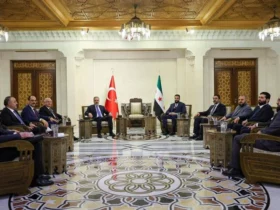







Leave a Reply